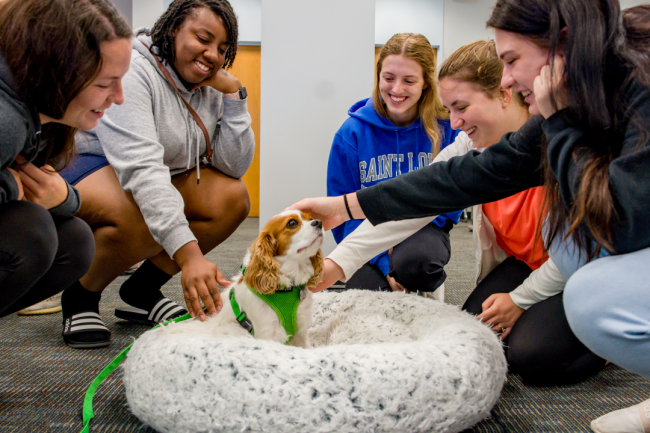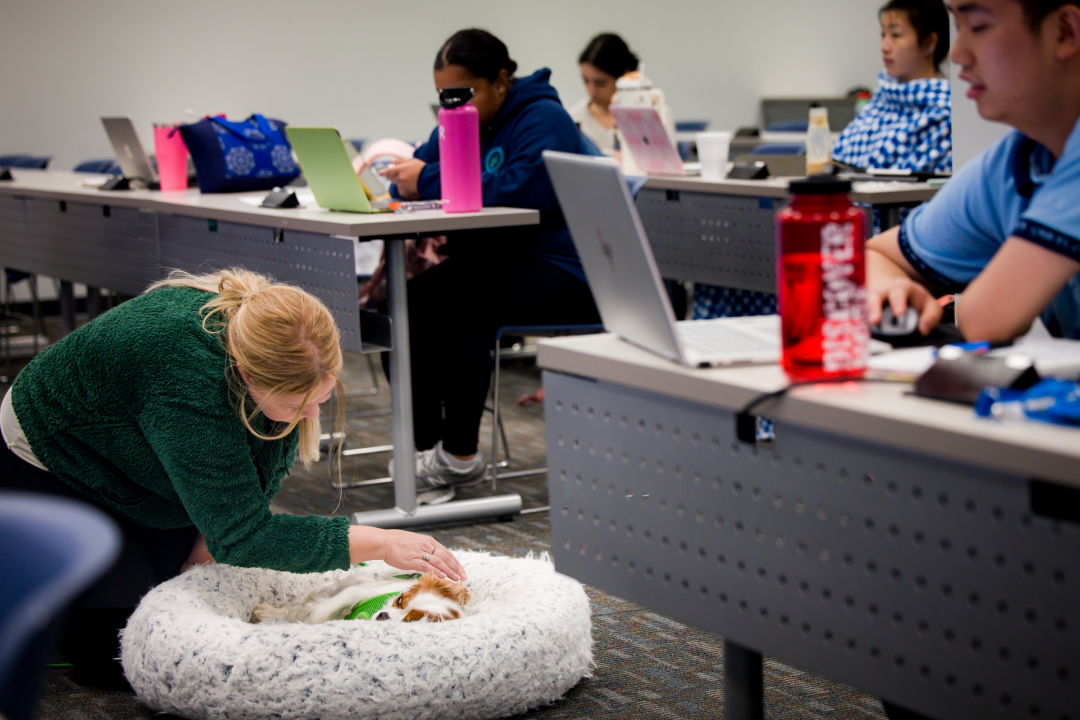You have /5 articles left.
Sign up for a free account or log in.

Students interacting with a dog before, on breaks from or after class show increased levels of joy and decreased levels of stress.
Sarah Conroy, Saint Louis University
Therapy dogs are common visitors to college campuses during periods of high stress such as midterms or final exams, but now more colleges and universities are including comfort animals and therapy dogs on campuses to combat student mental health concerns on a daily basis.
One nursing professor at Saint Louis University in Missouri sought to see how students experiencing high academic stress could benefit from a therapy dog present in the classroom all the time, rather than in short interventions. After a pilot study, researchers found that therapy dogs could improve stress, anxiety and happiness and the dog was not distracting from the learning environment.
A dog-size hole: Nursing students are likely to experience psychosocial stress (reflective of perceived social threats including social evaluation, exclusion and achievement related to goal-directed performance) in their internships, with employment stress being the first stressor, according to a 2022 research article.
Stress can grow among nursing students as they become more engaged in clinical settings, distancing them from a more familiar campus life, according to researchers.
In her own classroom, Margaret Bultas, a professor at Saint Louis’s Trudy Busch Valentine School of Nursing and principal researcher for this study, observed rising stress and anxiety levels among nursing students.
Bultas increased mindfulness education and was curious to see how bringing a therapy dog to campus would benefit students over time.
Canine in class: SLU created a bring your dog to work policy in 2011, allowing responsible dog owners to bring one dog to work, so long as they were house-trained, quiet, healthy and engaged well with other people.

School of Nursing professor Margaret Bultas with Jessie, her certified therapy dog, on July 19, 2023.
Sarah Conroy, Saint Louis University
Bultas brought her own dog, Jessie, a 3-year-old Cavalier King Charles spaniel and a certified therapy dog. To test her effect on students, Jessie would be present for one section of Bultas’s course, but not the other, to serve as the control. In total, 67 undergraduate nursing students participated in the study—36 in the intervention and 31 for the control.
The two classes had the same instructor on the same day of the week, covering the same content with the same syllabus and examinations. All participants completed a demographic form and a pre- and postquestionnaire ranking their anxiety, stress and happiness on a scale from one to 10 as well as answering open-ended questions.
When Jessie was in class, students could interact with her physically before, during a break and after class, for a total of two hours. Jessie stayed in her bed at the front of the classroom while Bultas was teaching and did not roam the room.
Paw-sitive impact: The pilot set out to understand the feasibility and acceptability of including a therapy dog in college courses, and both goals were met.
At the end of the term, students reported positive feelings from having a therapy dog in class, including added joy and happiness, and they considered Jessie an overall benefit to the classroom.

Jessie, a certified therapy dog, attends School of Nursing professor Margaret Bultas’s class on July 19, 2023.
Sarah Conroy, Saint Louis University
Initially, surveyed students indicated the dog would be a possible distraction in the classroom, but this worry was not reflected to the same level in the post-test survey as a challenge to the learning environment. Researchers did note Jessie’s temperament and behavior made the pilot more feasible, as she was well trained and never had to be removed for being distracting.
After the intervention, a majority of students (both in the control and test groups) said they would like to have a dog in the classroom—and only one student did not want a dog in the classroom.
Do you have a wellness tip that might help others encourage student success? Tell us about it.




